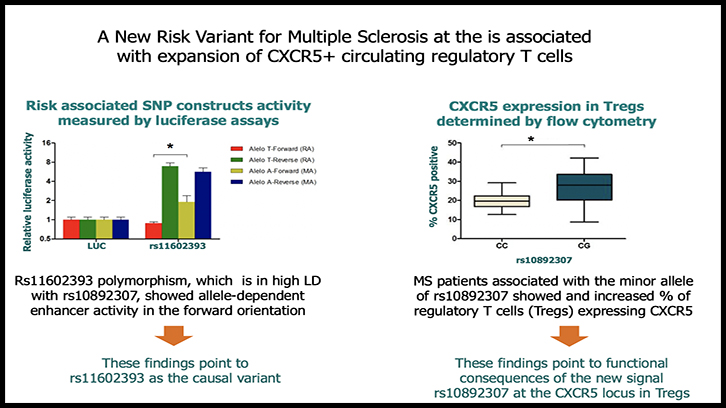A New Risk Variant for Multiple Sclerosis is associated with the expansion of CXCR5+ circulating regulatory T cells

Knowing more genetic variants linked to the expression of Multiple Sclerosis (MS) would help to identify the effects that these trigger and to define the focus of analysis in order to unmask the causes that provoke the disease. The group of the Neurology- Neuroimmunology Service from the Multiple Sclerosis Center of Catalonia (Cemcat) and from the Research Institute Vall d’Hebron (VHIR) of the University Hospital Vall d’Hebron has investigated genes linked to MS, of which has identified three relevant variants. A variant of the CXCR5 gene stands out due to the deficient mechanisms that it activates and, therefore, the indications that would explain the association of the gene with the MS.
Genome-wide association studies have contributed to the identification of approximately 200 loci associated with multiple sclerosis (MS). However, a proportion of MS heritability remains unknown. In this study, the main objective was the identification of new genetic variants associated with the risk of MS, as well as the characterization of the possible functional consequences of the new variants.
In a first phase of the study, DNA resequencing of risk genes for the disease was performed in a cohort of 1,070 MS patients and healthy controls. A total of 32 genetic variants associated with MS were identified. In a second or validation phase of the study, these 32 genetic variants were genotyped in an independent cohort of 3,450 patients with MS and 1,688 healthy controls, with the contribution of centers belonging to the Spanish Network on MS (REEM). The three genetic variants that were validated in the independent cohort of patients and controls were the following: (i) the rs10892307 variant located in the CXCR5 gene (CXC motif chemokine receptor 5), with a p-value of 1.37x10-6 and an odds ratio of 0.77; (ii) the rs2762943 variant located in the CYP24A1 gene (cytochrome P450 family 24 subfamily A member 1), with a p-value of 0.04 and an odds ratio of 1.16; and (iii) the rs1599932 variant positioned in the TSFM gene (Ts translation elongation factor, mitochondrial) with a p-value of 0.001 and an odds ratio of 0.85.
Subsequent studies focused on the rs10892307 variant of the CXCR5 gene, which was the most significantly associated with the disease. Conditional logistic regression analysis showed that the rs10892307 variant constituted a new independent signal in the CXCR5 gene, and a study using the dual-luciferase reporter assay revealed that the rs11602393 variant, which is in high linkage disequilibrium with rs10892307, increased the CXCR5 promoter transcriptional activity, suggesting that rs11602393 could be the causal variant explaining the association with MS.
Finally, immunophenotyping and subsequent analysis by flow cytometry in different peripheral blood cell populations showed that the percentage of regulatory T lymphocytes expressing CXCR5 was found to be significantly increased in patients with MS carrying the minor allele for rs10892307. Such an expansion of circulating regulatory T cells positive for CXCR5 may be considered as the functional consequence of this genetic variant associated with the risk of MS, and could lead to a defective germinal center reaction and ultimately to an increase in the production of autoantibodies.
Manuel Comabella López 1,2
1 Medicine Department. Universitat Autònoma de Barcelona (UAB).
2 Multiple Sclerosis Center of Catalonia (Cemcat).
References
Gil-Varea, E., Fedetz, M., Eixarch, H., Spataro, N., María Villar, L., Urcelay, E., Saiz, A., Fernández, Ó., Leyva, L., Ramió-Torrentà, Ll., Vandenbroeck, K., Otaegui, D., Castillo-Triviño, T., Izquierdo, G., Malhotra, S., Bosch, E., Navarro, A., Alcina, A., Montalban, X., Matesanz, F., Comabella, M. A New Risk Variant for Multiple Sclerosis at 11q23.3 Locus Is Associated with Expansion of CXCR5+ Circulating Regulatory T Cells. Journal of Clinical Medicine. 2020; 9(3): 625. DOI: 10.3390/jcm9030625

